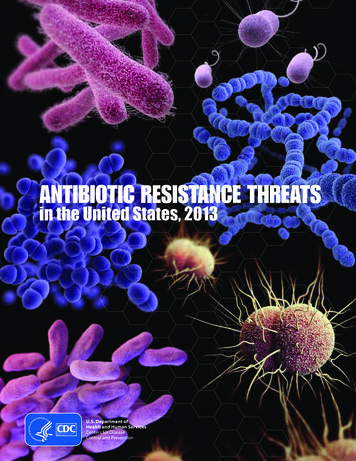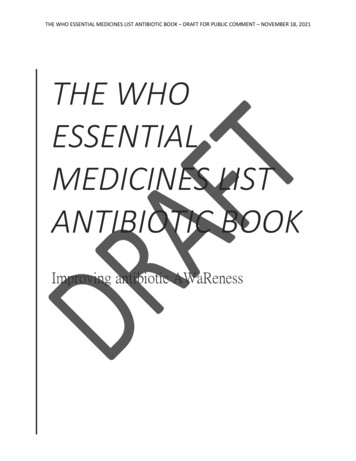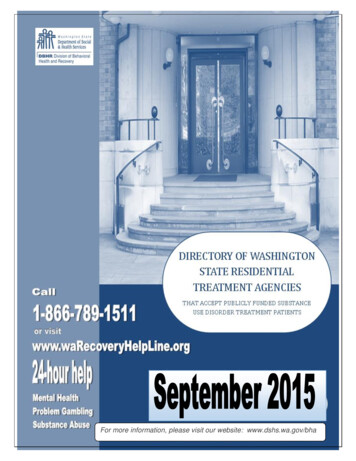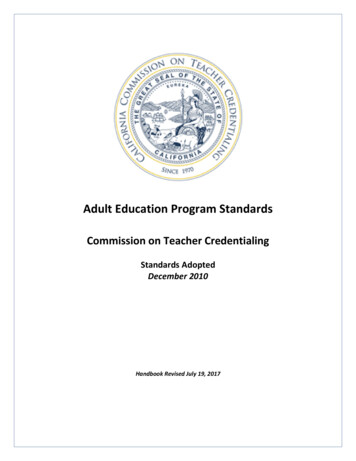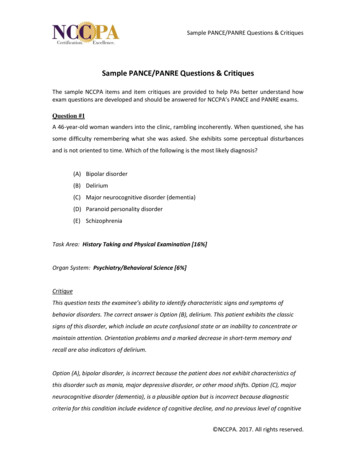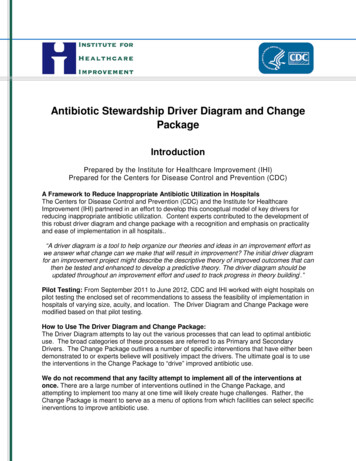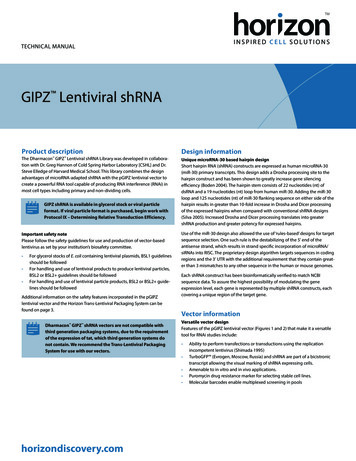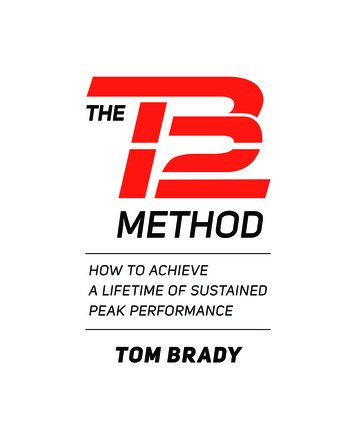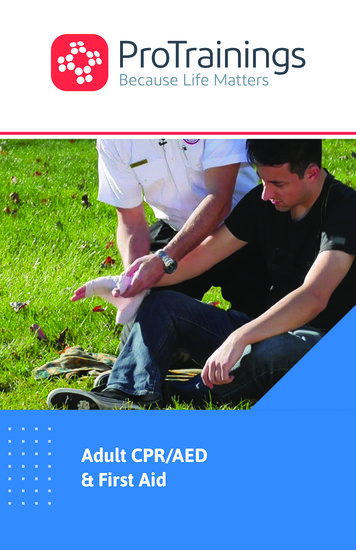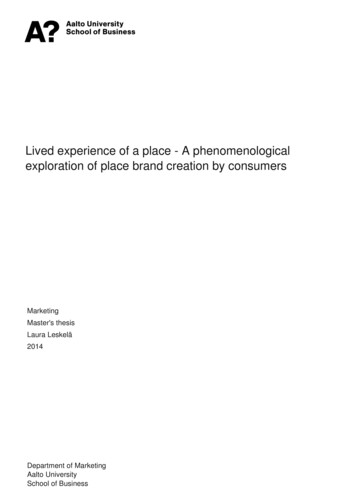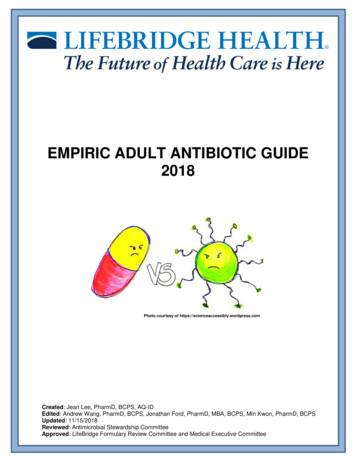
Transcription
EMPIRIC ADULT ANTIBIOTIC GUIDE2018Photo courtesy of https://scienceaccessibly.wordpress.comCreated: Jean Lee, PharmD, BCPS, AQ-IDEdited: Andrew Wang, PharmD, BCPS, Jonathan Ford, PharmD, MBA, BCPS, Min Kwon, PharmD, BCPSUpdated: 11/15/2018Reviewed: Antimicrobial Stewardship CommitteeApproved: LifeBridge Formulary Review Committee and Medical Executive Committee
PURPOSETo optimize empiric antibiotic use at LifeBridge Health (LBH) hospitals, this guide was developed to assist clinicianson prescribing appropriate empiric antibiotic regimens. This guide was developed by the Antimicrobial StewardshipCommittee and approved by the LBH Medical Executive Committee. These regimens are based on nationalstandard guidelines for the specified indications, with adaptation to the LifeBridge formulary and antibioticsusceptibility patterns.DISCLAIMERThe recommendations given in this guide are meant to serve as treatment guidelines. They should not supersedeclinical judgment and/or infectious diseases consultation when indicated. These recommendations were developedfor use at LBH hospitals only, and may not be appropriate for other settings. We have attempted to verify that allinformation is correct but information may change with continuing research. If there are questions or concerns,please email the Antimicrobial Stewardship Committee Chair.NOTE: DOSING RECOMMENDATIONS ARE BASED ON NORMAL RENAL/HEPATIC FUNCTIONKEYRX Consider Pharmacy Dosing Service (must meet criteria) or refer to nomogram for dosing Restricted antibiotic that must meet restriction criteria or requires Antimicrobial Stewardship or ID approvalID Recommend ID consultGI Recommend GI consultSURG Recommend Surgery consultRed print indicates preferred antibiotic regimen and should be considered first when possible.Non-restricted AntibioticsAmikacin IV ( )Amoxicillin PO ( )Amox/clav PO ( )Ampicillin IV ( )Amp/sulbactam IV ( )Azithromycin IV/PO ( )Cefazolin IV ( )Cefotetan IV ( )Cefepime IV ( )Ceftriaxone IV ( )Cefuroxime IV/PO ( )Cephalexin PO ( )Ciprofloxacin IV/PO ( )Clarithromycin PO ( )Clindamycin IV/PO ( )Dicloxacillin PO ( )Doxycycline IV/PO ( )Gentamicin IV ( )Levofloxacin IV/PO ( )Metronidazole IV/PO ( )Nafcillin IV ( )Nitrofurantoin PO ( )Penicillin G IV ( )Piperacillin/tazobactam IV ( )Penicillin VK PO ( )Rifampin PO ( )Tobramycin IV ( )TMX/SMZ IV ( )TMX/SMZ PO ( )Vancomycin IV ( )Vancomycin PO ( )Restricted AntibioticsAztreonam IV ( )Ceftaroline IV ( )Dalbavancin IV ( )Daptomycin IV ( )Ertapenem IV ( )Fidaxomicin PO ( )Fosfomycin ( )Linezolid IV( )Linezolid PO ( )Meropenem IV ( )Tigecycline ( )Cost Key : 10/day : 10-50/day : 50-100/day : 100-200/day : 200/day
Community-Acquired Pneumonia (CAP)Type/SeverityEmpiric Antibiotic RegimenInpatientAmpicillin/sulbactam IV 1.5g-3g Q6HORAmoxicillin/clavulanate PO 875 mg BIDORCeftriaxone IV 1g QDay(No concern forPseudomonas)1DurationPLUSAzithromycin PO 500 mg QDayAny of the above regimenInpatient ICULevofloxacin IV/PO 750 mg QDayPLUSCeftriaxone IV 1g QDayOutpatientAzithromycin PO 500 mg QDayORDoxycycline PO 100 mg BIDStep-downAmoxicillin/clavulanate PO 875 mg BIDORCefuroxime PO 500 mg BIDMinimum of5 daysRe-assess after 5 days iflonger duration is needed
2Hospital-Acquired Pneumonia (HAP)[with or without sepsis – NOT on ventilator]Type/SeverityNot at high-risk formortalityIncreased MRSA riskEmpiric Antibiotic RegimenDurationCefepime IV 2g Q8H*ORLevofloxacin IV 750 mg QDayAbove regimenPLUSVancomycin IVRX(may use MRSA nasal screening to guide therapy)Need for ventilator supportORSeptic shockORHistory of MDROsStep-downCefepime IV 2g Q8H*OR7 days or shorterPiperacillin/tazobactam IV 3.375g Q8H(4-hr infusion)PLUSRXVancomycin IVPLUSAminoglycoside**RXSinai/Northwest: Tobramycin IVRXCarroll Hospital: Gentamicin IVORCiprofloxacin IV 400 mg Q8H1. If MRSA screen negative: consider stop vancomycin2. Pseudomonas not recovered: consider stop anti-pseudomonalcoverageNOTE:*Cefepime recommended given higher incidence of nephrotoxicity with29piperacillin/tazobactam vancomycin relative to cefepime vancomycin**Aminoglycoside should be used with caution; recommend consulting with ID before initiationVentilator-Acquired Pneumonia (VAP)[with or without sepsis]Type/Severity2Empiric Antibiotic RegimenDurationCefepime IV 2g Q8H*ORPiperacillin/tazobactam IV 3.375g Q8H(4-hr infusion)PLUSVancomycin IVRX7 daysPLUSAminoglycoside**RXSinai/Northwest: Tobramycin IVRXCarroll Hospital: Gentamicin IVORCiprofloxacin IV 400 mg Q8HStep-down1. Do not use aminoglycoside monotherapy2. Consider stopping antibiotics if patient’s respiratory status is improvingwithin 48 hours (i.e. if patient is coming off ventilator)
Aspiration Pneumonia vs. Aspiration Pneumonitis3,41. Antibiotics may NOT be necessary in those who develop fever, leukocytosis, and infiltrates within 48hours after aspiration as this likely reflects chemical pneumonitis. Treatment is only recommendedin patients who have symptoms for 48 hours or who are severely ill; recommended durationis 5-7 days.2. Anaerobic coverage needed only if history of chronic/recurrent aspiration.3. If treatment is needed, refer to appropriate pneumonia guideline in previous section.COPD Exacerbations5Empiric use of levofloxacin is discouragedType/SeverityConsider antibiotics ifincreased sputum purulenceAND any of the following:increased dyspnea, increasedsputum volume ORmechanically ventilated6Empiric Antibiotic RegimenDurationAzithromycin PO 500 mg3 daysDoxycycline PO 100 mg BIDORAmoxicillin/clavulanate PO 875 mg BID5 days
Skin and Soft Tissue Infections7,8NOTE: Clindamycin has reliable GAS coverage but unreliable S. aureus coverage. Nearly 35% of MSSA and50% of MRSA isolates at SHB, NWH, and CHC are resistant. See antibiogram.Type/SeverityEmpiric Antibiotic RegimenDurationPurulence I&DAntibiotics are optional (i.e. recurrent casesor abscesses 5 cm)Doxycycline PO 100 mg BIDORTMP/SMX (DS) PO 160/800 mg BIDMild InfectionsNon-purulence no I&D5 daysAmoxicillin PO 500 mg TIDORPenicillin VK PO 500 mg QIDORCephalexin PO 500 mg QIDORDicloxacillin PO 250 mg QIDPurulence I&DModerate InfectionsSSTI with ANY of the signs ofsystemic infection listed below:T 38 C, HR 90 bpm, RR 24or WBC 12,000Moderate-SevereInfections that meetfollowing criteria:1. Requiring IV Vancomycintherapy for 7-14 days2. Clinically stableDoxycycline PO 100 mg BIDORTMP/SMX (DS) PO 160/800 mg BIDNon-purulenceCefazolin IV 1-2 g Q8HORPenicillin G IV 2–4 million units Q4–6H5-7 daysWhile in ED/Observation: Vancomycin IVthen Dalbavancin** IV 1000 mg x 1 doseon discharge**Dalbavancin is restricted to ED or Observation patients with acute cellulitis who would otherwise need IV antibiotic therapy for 7-14days beyond discharge (i.e. recurrent failure with oral antibiotics, IVDA to avoid PICC, history of PICC thrombosis, leaving AMA, etc.)Severe Infections / Sepsis/ Chronic wound infectionChronic wound infectionsecondary to diabetes orchronic vascular issues;T 38 C, HR 90 bpm, RR 24,WBC 12,000 or 400 cells/μLor immunocompromisedVancomycin IVRXPLUSPiperacillin/tazobactam IV 3.375 g Q8H(4-hr infusion)ORCefepime IV 2 g Q12H Metronidazole IV/PO500 mg Q8-12H7-10 days7-10 days
Intra-abdominal Infections (IAI)TypeSeverity9Empiric Antibiotic RegimenDurationCefazolin IV 2gm Q8H Metronidazole IV 500 mg Q8HAppendicitisRupturedCiprofloxacin IV 400 mg Q12H Metronidazole IV 500 mg Q8HNote: e.coli resistance is 20% to ciprofloxacin,therefore, ciprofloxacin is only recommended for lifethreatening beta-lactam allergic patients11,12Mild – ModerateNote: anaerobic coverage not needed unless biliaryenteric anastomosis present13Mild – ModerateNo surgery: 10 days18Secondary bacteremia:9,217 daysSource control with9,21Bacteremia: 7 daysSource control: Stopantibiotic afterprocedureCefazolin IV 2g Q8HCholecystitisComplicated, postsurgery: 4 daysSource control: 3 daysCefazolin IV 2g Q8HCholangitisUncomplicated, postsurgery: 24 hoursNote: anaerobic coverage not needed unless biliaryenteric anastomosis presentNo surgery: 5-7 days9Piperacillin/tazobactam IV 3.375g Q8H(4-hour cin IV 400 mg Q12H Metronidazole IV 500 mg Q8HSource control: 4 daysNote: e.coli resistance is 20% to ciprofloxacin,therefore, ciprofloxacin is only recommended for lifethreatening beta-lactam allergic patientsDiverticulitisAcute,UncomplicatedConsider deferral of antibioticComplicatedCeftriaxone IV 1g Q24H Metronidazole IV 500 mg Q8HSource control: 4 days7after surgeryCefepime IV 2g Q12H Metronidazole IV 500 mg Q8HIncomplete source16control: 7-14 daysSeverely ill9Piperacillin/tazobactam IV 3.375g Q8H(4-hour infusion)TreatmentSBP or primary17peritonitisCeftriaxone IV 2g QDay5 daysCiprofloxacin PO 500 mg QDayProphylaxisTMP/SMX PO 160/800 mg QDayIndefinite14
Intra-abdominal Infections (IAI)9TypeSeverityEmpiric Antibiotic RegimenPeritonitis inDiagnostic criteriaPD fluid with 1003cells/mm with 50%neutrophilpredominanceINTRA-PERITONEAL DOSINGCefazolin IP 15-20 mg/kg Q24HORVancomycin IP 15-30 mg/kg Q5-7 daysPLUSANDGentamicin IP 0.6 mg/kg Q24HPositive PD fluidcultureVancomycin IP 15-30 mg/kg Q5-7 days Cefepime IP 1g Q24HPD patients18No treatmentDurationCoag-neg staph/strepspp: 14 daysS. aureus, enterococcus,P. aeruginosa,Enterobacteriaceae:21 daysNOTE: Do not use antibiotics to preventinfection in severe or necrotizingpancreatitis. Antibiotic are not1recommended in most casesCriteria for antibiotics1. Pancreatic necrosis confirmed by CT andthe necrosis is suspected to be infected2. Deteriorates after 7-10 days ofhospitalization. Fine needle aspiration forculture recommendedAcute19PancreatitisTreatment3. Suspicion for systemic (extrapancreatic)infection regardless of association withacute pancreatitisCiprofloxacin IV 400 mg Q12H Metronidazole IV/PO 500 mg Q8H10-14 daysPiperacillin/tazobactam IV 3.375g Q8H(4-hr infusion)Cefazolin IV 2g Q8H Metronidazole IV/PO 500 mg Q8-12HMild-ModerateCiprofloxacin IV 400 mg Q12H Metronidazole IV/PO 500 mg Q8HNote: e.coli resistance is 20% to ciprofloxacin,therefore, ciprofloxacin is only recommended for lifethreatening beta-lactam allergic patientsGeneral IAISevere or HealthCare associatedCefepime IV 2g Q12H Metronidazole IV/PO 500 mg Q8HPiperacillin/tazobactam IV 3.375g Q8H(4-hr infusion)Source control: 4 days9after surgeryMedical management:5-7 days, then reassess9for the need for surgerySecondary bacteremia:9,217 days
Clostridium difficile Infections (CDI)22Metronidazole has higher failure rates relative to vancomycin and fidaxomicin and is no longer a first-lineagentEpisodeSeverityMild-ModerateWBC 15 AND SCr 1.5Definitive TherapyVancomycin PO 125 mg QIDIDInitialMetronidazole should only beused for outpatient therapywhen oral vancomycin is notan option or unavailableSevereWBC 15 OR SCr 1.5FulminantID/SURGHypotension/shock,megacolon, ileusFirst recurrenceDurationVancomycin PO 125 mg QIDVancomycin PO 500 mg QID Metronidazole IV 500 mg TIDAdd vancomycin enema if ileuspresentFollow initial episode regimenOR Fidaxomicin PO 200 mg BID10 daysBased on clinicalresponse10 daysFecal microbiota transplantGI(FMT)Recurrence/relapseSecond or morerecurrenceVancomycin Taper PulseVancomycin PO 125 mg QIDfor 10 daysthenVancomycin PO 125 mg BIDfor 7 daysthenVancomycin PO 125 mg QODfor 6 weeksAvoid: antimotility medications (loperamide, diphenoxylate), proton pump inhibitors (PPIs)No data for probiotic use8 weeks
Urinary Tract Infection (UTI)23,24,25- For catheter-associated UTIs (CAUTI), remove (preferred) or replace catheter before treatment- Consider signs/symptoms, the presence of urinary catheter, and quality of specimen collection beforeinitiation of treatment- Avoid the use of fluoroquinolones for lower tract infection per FDA warning- Collection of cultures in the absence of signs/symptoms should be avoidedEmpiric Antibiotic RegimenType/LocationAsymptomaticBacteriuriaUA positive urine culture 50-100,000ANDDetermine best drug choicebased on allergies and history ofUTI / MDROsDurationUncomplicatedcystitis in a femalewithout urologicabnormality orcatheterComplicatedUTI in male or ifurologic abnormality,pregnancy, or catheterDO NOT TREATEXCEPTIONS:1. Pregnant2. Undergoing urologic procedure withexpected mucosal bleedingNO signs and symptomsCephalexin PO 500 mg BID3-5 daysNitrofurantoin PO 100 mg BID5 daysTMP/SMX PO 160/800 mg BID3 days5-7 daysLower Tract InfectionUA positive urine culture 50-100,0005 daysANDLOCALsigns and symptomsUpper Tract InfectionLOCAL AND SYSTEMICsigns and symptomsSeptic Shocksecondary to UTIProstatitisCiprofloxacin IV 400 mg Q12H7 daysNo history of PseudomonasCeftriaxone IV 1g Q24HHistory of PseudomonasCefepime IV 1g Q12HMinimum of7 daysLife-threatening reaction to beta-lactamRXGentamicin IV Meropenem IV 2g Q8H(3-hr infusion)7 days
Febrile Neutropenia26,27,28Fever: single oral temp 38.3ºC or temp 38ºC sustained for 1 hour33Neutropenia: ANC 500 cells/mm or ANC predicted to decrease to 500 cells/mm in 48 hoursRisk LevelEmpiric TherapyDurationCiprofloxacin PO 500-750 mg BIDFever of Unknown Origin (FUO)LOWIf anticipate shortneutropenic period of 7 days no/fewco-morbid conditions(hypotension, pneumonia,new-onset abdominal pain,or neurologic changes)PLUSAmoxicillin/clavulanate PO 875 mg BIDORClindamycin PO 300-450 mg Q6HIdentified infectionCefepime IV 2g Q8HORPiperacillin/tazobactam IV 3.375g Q8H(4-hr infusion)HIGHIf anticipate prolongedneutropenic period 7daysStop antibiotic once afebrile x24 hoursAND3ANC 500 cells/mmConsider adding vancomycin IV ONLY IFsuspected vascular catheter-relatedinfections, SSTI, pneumonia orhemodynamic instability. Vancomycinshould be discontinued if target Grampositive organism is not recovered incultureLife-threatening reaction to beta-lactam Aztreonam IV 2g Q8H RXVancomycin IVIF PERSISTENT FEVER after 4-7 DAYSConsider antifungal therapyID Consult is recommended3Treat until ANC 500 cells/mmAND for recommended duration
CNS InfectionsFor BACTERIAL meningitis, administer dexamethasone IV 0.15 mg/kg Q6H (10 mg max) 10-20 min before(or concomitantly with) the first dose of antibiotics, up to 4 days max.Dexamethasone may be stopped if no strep. pneumoniae ric Antibiotic RegimenCommunity-acquired(Age 18-50 years)Ceftriaxone IV 2g Q12H RXVancomycin IVCommunity-acquiredAge 50 years or withimmunosuppression oralcoholismCeftriaxone IV 2g Q12H RXVancomycin IV Ampicillin IV 2g Q4HPost-neurosurgery,penetrating trauma or CSFshuntCefepime IV 2g Q8H RXVancomycin IVHSV EncephalitisEmpirical therapy for HSV encephalitismay be started if neurologic symptoms(altered MS, hallucination, seizures,etc.) /- edema / hemorrhage is noted inbrain MRI or CTAcyclovir IV 10 mg/kg Q8H(Use IBW only. If actual body weight isless than IBW, use actual body weight)DurationN. meningitides / H. influenza:7 daysS. pneumoniae, GNR or L.monocytogenes: 10-14 daysStaph aureus: minimum of 21daysNote: CSF should be negativefor at least 10 days before VPshunt placement14- 21 daysID Consult is recommended
Sepsis/Septic Shock of Unknown SourceSEPSIS: A life-threatening organ dysfunction caused by a dysregulated host response to an infection qSOFA ( 2 of below) may be used for bedside assessment for sepsiso Respiratory rate 22 breaths/mino altered mentation (Galsgow Coma Scale score 15)o systolic blood pressure 100 mmHg30SEPTIC SHOCK: Subset of sepsis with circulatory and cellular/metabolic abnormalities profound enough to18substantially increase mortality . In addition to sepsis, these patients have: Persisting hypotension requiring vasopressors to maintain MAP 65 mmHg AND Serum lactate level 2 mmol/L despite adequate volume resuscitationType/SeverityEmpiric Antibiotic RegimenSepsisInitiate appropriate antibiotics based on the suspected primary siteof infectionDurationMay consider 2 active agents against GNR (or MDRO basedon patient’s history)Cefepime IV 2g Q8HORPiperacillin/tazobactam IV 3.375g Q8H(4-hr infusion)ORSeptic shock Meropenem IV 2g Q8H (3 hour infusion)Empiric: 3 daysStep-down based onculture result(primarily for septic shock due to urosepsis or history of ESBL)WITH OR WITHOUTRXAminoglycoside **ORCiprofloxacin 400mg IV q8hIF MRSA COVERAGE IS WARRANTEDRXVancomycin IV**Aminoglycoside should be used with caution; recommend consulting with ID before initiation
References1. Mandell LA, Wunderink RG, et al. Infectious Diseases Society of America/American Thoracic Society ConsensusGuidelines on the Management of Community-Acquired Pneumonia in Adults. Clin Infect Dis 2007;44: S27-72.2. Kalil AC, Metersky ML, et. al. Management of Adults With Hospital-acquired and Ventilator-associated Pneumonia:2016 Clinical Practice Guidelines by the Infectious Diseases Society of America and the American Thoracic Society. ClinInfect Dis 2016:63 e63-68.3. Johns Hopkins Antibiotic Guide (Aspiration Pneumonia). Last updated /Johns Hopkins ABX Guide/540441/all/Pneumonia Aspiration. Accessed6/15/17.4. Marik PE. Aspiration Pneumonitis and Aspiration Pneumonia. N Engl J Med 2001:344(9); 665-671.5. Global Initiative for Chronic Obstructive Lung Disease (GOLD). GOLD 2017 global strategy for the diagnosis,management, and prevention of chronic obstructive pulmonary disease, 2017 report. November 17, -diagnosis-management-prevention-copd/. Accessed 7/27/2017.6. Zhang HI, Tan M, et al. Antibiotics for the treatment of acute exacerbation of chronic obstructive pulmonary disease: anetwork meta-analysis. BMC Pulm Med 2017: DOI 10.1186/s12890-017-0541-07. Stevens DL, Bisno AL, et. al. Practice Guidelines for the Diagnosis and Management of Skin and Soft Tissue Infections:2014 Update by the Infectious Diseases Society of America. Clin Infect Dis 2014:59 e11.8. Daum RS, Miller LG, et al. A placebo-controlled trial of antibiotics for smaller skin abscesses. N Engl J Med 2017:376:2545-2555.9. Solomkin JS, Mazuski JE, et al. Diagnosis and management of complicated intra-abdominal infection in adults andchildren: Guidelines by the Surgical Infection Society and the Infectious Diseases Society of America. Clin Infect Dis 2010;50(15):133-164.10. Mazuski JE, Tessier JM, May AK, Sawyer RG, Nadler EP, Rosengart MR, et al. The surgical infection society revisedguidelines on the management of intra-abdominal infection. Surg Infect. 2017;18:1–76. doi: 10.1089/sur.2016.261.11. Salminen P, Paajanen H, Rautio T, et al. Antibiotic therapy vs appendectomy for treatment of uncomplicated acuteappendicitis. JAMA. 2015;313(23):2340–8.12. van Lent AU, Bartelsman JF, Tytgat GN, et al. Duration of antibiotic therapy for cholangitis after successfulendoscopic drainage of the biliary tract. Gastrointest Endosc. 2002 Apr;55(4):518-22. PMID: 11923764.13. Kogure H, Tsujino T, Yamamoto K, et al. Fever-based antibiotic therapy for acute cholangitis following successfulendoscopic biliary drainage. J Gastroenterol. 2011 Dec;46(12):1411-7. PMID: 21842232.14. Regimbeau JM, Fuks D, Pautrat K, et al. Effect of postoperative antibiotic administration on postoperative infectionfollowing cholecystectomy for acute calculous cholecystitis: a randomized clinical trial. JAMA. 2014 Jul;312(2):145-54.PMID: 25005651.15. Sawyer RG1, Claridge JA, Nathens AB, et al. Trial of short-course antimicrobial therapy for intraabdominal infection. NEngl J Med. 2015 May 21;372(21):1996-2005. PMID: 25992746.16. Schug-Pass C, Geers P, Hügel O, et al. Prospective randomized trial comparing short-term antibiotic therapy versusstandard therapy for acute uncomplicated sigmoid diverticulitis. Int J Colorectal Dis. 2010 Jun;25(6):751-9. PMID:20140619.17. Bookstaver PB. Clostridium difficile Infection and Common Intra-abdominal Infections. ACCP Updates in Therapeutics2018: Infectious Diseases Pharmacy Preparatory Review Course.18. Baskol M, Gursoy S, Baskol G, et al. Five days of ceftriaxone to treat culture negative neutrocytic ascites in cirrhoticpatients. J Clin Gastroenterol 2003; 37: 403-5.19. Li PK, Szeto CC, Piraino B, et al. ISPD Peritonitis Recommendations: 2016 Update on Prevention and Treatment.Peritoneal Dialysis International, Vol. 36, pp. 481–508.
20. Tenner S, Baillie J, DeWitt J, et al. American College of Gastroenterology guideline: management of acutepancreatitis. Am J Gastroenterol 2013;108:1400 -15.21. Chotiprasitakul D, Han JH, Cosgrove SE, et al. Comparing the outcomes of adults with enterobacteriaceae bacteremiareceiving short-course versus prolonged-course antibiotic therapy in a multicenter, propensity score-matched cohort. ClinInfect Dis. 2018 Jan 6;66(2):172-7. PMID: 29190320.22. McDonald LC, Gerding DN, et. al. Clinical Practice Guidelines for Clostridium difficile infection in adults and children:2017 Update by the Infectious Diseases Society of America (IDSA)and Society for Healthcare Epidemiology of America(SHEA). Clin Infect Dis. 2018:XX(00):1-48.23. Nicolle LE, Bradley S, et al. Infectious Diseases Society of America guidelines for the diagnosis and treatment ofasymptomatic bacteriuria in adults. Clin Infect Dis 2005;40:643-654.24. Hooton TM, Bradley SF, et al. Diagnosis, prevention, and treatment of catheter-associated urinary tract infection inadults:2009 international clinical practice guidelines from the Infectious Diseases Society of America. Clin Infect Dis2010:50(1):625-663.25. Gupta K, Hooton TM, Naber KG, et al. International clinical practice guidelines for the treatment of acuteuncomplicated cystitis and pyelonephritis in women: A 2010 update by the Infectious Diseases Society of America and theEuropean Society for Microbiology and Infectious Diseases. Clin Infect Dis 2011;52(5):e103–e120.26. NCCN Clinical Practice Guidelines in Oncology: Prevention and Treatment of Cancer-Related Infections Version2.2017. https://www.nccn.org/professionals/physician gls/pdf/infections.pdf. Accessed 6/15/17.27. Freifeld AG, Bow EJ, Sepkowitz KA et al. Clinical practice guideline for use of antimicrobial agents in neutropenicpatients with cancer: 2010 update by the infectious disease society of America. Clin Infect Dis 2011;52(4):e56-e93.28. Flowers CR, Seidenfeld J, Bow EJ et al. Antimicrobial prophylaxis and outpatient management of fever andneutropenia in adults treated for malignancy: American society of clinical oncology clinical practice guideline. J OncolPract 2013;31:794-810.29. Rutter WC, Cox JN, Martin CA, et al. Nephrotoxicity during vancomycin therapy in combination withpiperacillin/tazobactam or cefepime. Antimicrobial Agents and Chemotherapy 2017;61(2): e02089-16.30. Singer MS, Deutschman CS, Seymour CW et al. The Third International Consensus Definitions for Sepsis and SepticShock (Sepsis-3). JAMA. 2016;315(8):801-10.
EMPIRIC ADULT ANTIBIOTIC GUIDE 2018 Photo courtesy of https://scienceaccessibly.wordpress.com Created: Jean Lee, PharmD, BCPS, AQ-ID Edited: Andrew Wang, PharmD, BCPS, Jonathan Ford, PharmD, MBA, BCPS, Min Kwon, PharmD, BCPS Updated: 11/15/2018
